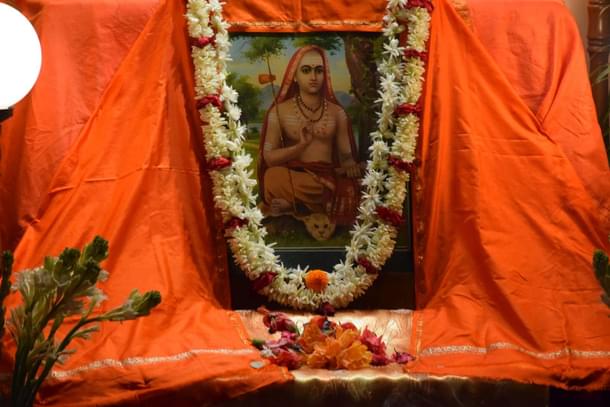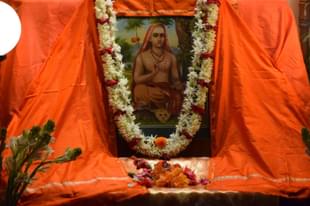Ideas
'When Did Adi Shankaracharya Live?' Is An Important Question For These Reasons
Venu Gopal Narayanan
Feb 25, 2024, 06:25 PM | Updated 06:25 PM IST
Save & read from anywhere!
Bookmark stories for easy access on any device or the Swarajya app.


Historians have spent a century trying to determine when Adi Shankaracharya lived. Thus far, a total lack of archaeological evidence has frustrated their efforts. Instead, many have employed linguistic tools to assume that he lived sometime in the 8th to 9th centuries of the common era (CE).
While these arguments may appear convincing to the lay reader, they are all no more than inconclusive guesstimates; the simple truth is that we do not yet know when this remarkable mind bound our sacred land together using the logic of Advaita.
On the other hand, the Kanchi Kamakoti Peetham at Kanchipuram, in Tamil Nadu, maintains a list of head seers which says that it was founded by Shankara in 509 BCE. That is about 1500 years earlier than modern guesstimates The lineage list of the Govardhana Matha in Puri, Odisha, starts in 484 BCE. Similarly, the Dwaraka Matha in Saurashtra, Gujarat, maintains that it was established in 475 BCE.
The natural response for a Left Liberal thinker would be to declare a date of 6th century BCE as preposterous, and instantly dismiss it out of hand as some hoary tradition with no scientific basis. But the Dharmic approach would be to test this thesis: what would be the impact on our history as we know it, if Shankara had indeed lived in the time of King Bimbisara of Magadha, Gautama the Buddha, and Mahavira the Tirthankara?
The most important test is whether such a date clashes with the dates of those texts referred to by Shankara in his works. Let us take the main ones:
One, the Brahma Sutra of Rishi Badarayana, which encapsulates the essence of the Upanishads (the concept of brahman, and Vedanta) into dense aphorisms. Its opening line is, Athato Brahma Jignyasa (‘then, therefore, the enquiry into Brahman’). The basis of Shankara’s Advaita is his commentary on this work, called the Brahma Sutra Bhashya.
In the absence of any evidence, historians have dated this text with ‘great accuracy’ to either the 5th or 2nd centuries BCE, or the 5th century CE.
Two, the Purva Mimamsa Sutra of Rishi Jaimini, who was an older contemporary of Rishi Badarayana. It aphoristically condenses the essence of the Brahmanas, Vedic texts detailing rituals and the concept of dharma. Its opening line is, Athato Dharma Jignyasa (‘then, therefore, the enquiry into Dharma’). According to some legends, Shankara bested Mandana Mishra, the greatest proponent of Mimamsa, in a debate once, to establish the validity of Advaita with the ritualists.
Dating this text with any degree of assurance is an absolute non-starter because of nil epigraphical evidence till the medieval period. All we know is that it was composed in the same time period as the Brahma Sutra, since one cross-references the other.
Three, the Bhagavad Gita, and by extension, the two epics. Shankara interpreted this celestial song using the logic of Advaita to demonstrate that it is the epitome of Vedic thought.
Once again, certain schools of historiography have gone to great pains to try and peg the Gita to a time after the Buddha, all without evidence of course. Assumptions chase conjectures through hoops of linguistics and philology to emerge as fact on the stages of academia.
There is a central reason why so much futile effort is expended: the date of the Vedas has to be held to 1500 BCE. Only then can horse-riding Aryans move from the steppes of Central Asia to the subcontinent. Only then can a yawning gap be created between the Vedic age and the supposedly earlier, supposedly different-in-every-way, Harappan/ Sindhu-Saraswati era.
Only then can Videgha Madhava of the Satapatha Brahmana carry Agni eastwards from the Saraswati River, around 1000 BCE, clear the forests along the Gandak, and settle his steppe folk in the Gangetic Plains. Now, in a tearing rush, the civilization can take root, compose the Upanishads, give birth to kingdoms, dynasties, legends, and initiate a lengthy intellectual journey which leads some millennia later to Shankara and Advaita.
However, if Shankara can be dated to the 6th century BCE, this elaborately fabricated historiography goes for a toss. Instead, and to the horror of our Marxist brethren, the date of Agni’s eastward journey gets pushed back by a thousand years at least, to well before the date they set for the Rig Veda, and bang in the middle of the Harappan era.
What Aryan invasion or migration theory then? This is what happens when our history is written for us by others, and what will persist if we allow that nefarious process to continue blithely forth without rigorous, scholarly contestation.
But mindsets are rapidly changing. The old assumptions are being hotly questioned, on merit. New data and new research show that Sanskrit is older than the ‘Indus Valley Civilization’, and, that Pali had evolved as a separate language by 4000 years ago. The discovery of the Sinauli chariot is both a new chapter of our ancient history waiting to be written, and the rewriting of conventional historiography; and one which points towards a far older date for Vidhega Madhava’s eastward passage.
Thus, we see that there is nothing in Shankara’s works which contradict his dating to the 6th century BCE, nor historical evidence to either support or disprove a belief that Bimbisara, the Buddha, and Mahavira were his contemporaries. But if this is so, then it turns some preconceived notions on their heads.
Rather than someone who contested the metaphysical intricacies of Buddhism only when it was deep into terminal decline in the subcontinent, which is how Shankara is popularly portrayed in modern scholarship, it means that he could have been there at the start, when the proliferation of heterodox sects began.
A date of 6th century BCE actually makes a lot more sense than one of 8th to 9th CE, because the motivations become a lot clearer, for bringing brahman and dharma (in essence, knowledge and action) together under one philosophical roof, for reinforcing the supremacy of the Vedas, and, for logically establishing with clear deductions, the umbilical Vedantic linkages between the Vedas, the Upanishads, and the Bhagavad Gita. It is all the philosophical protection Sanathana Dharma has ever needed to fend off the vagaries of history, and to preserve our way of life in our sacred land.
We may probably never know for sure which era Shankara lived in, but it feels good to imagine that a Malayalee monk from Kaladi may have met and conversed with some great Biharis, in Sanskrit, in Uttar Pradesh, at a time of tremendous intellectual churn.
Venu Gopal Narayanan is an independent upstream petroleum consultant who focuses on energy, geopolitics, current affairs and electoral arithmetic. He tweets at @ideorogue.





